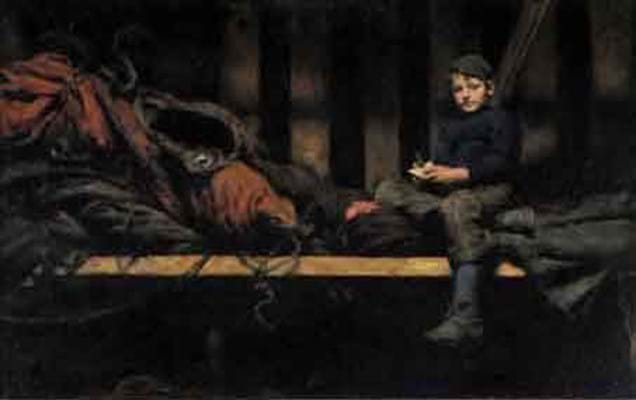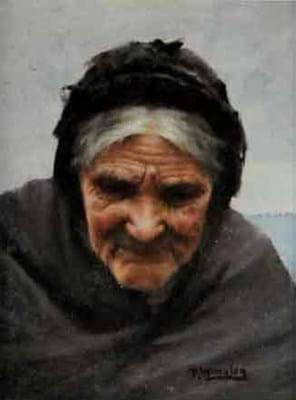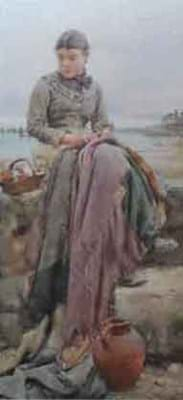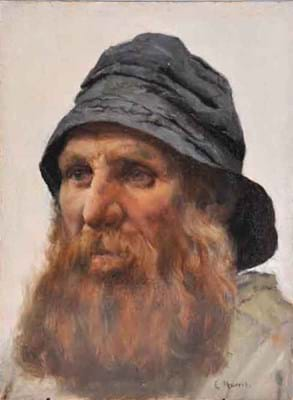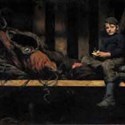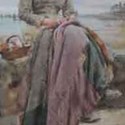Back in the late 1980s, they provided a string of headline-grabbing results in the saleroom. But since then, although prices for artists like Laura Knight (1877-1970) have continued to rise, buyers' tastes have moved on somewhat from pre-First World War works and more towards the later 20th century.
Nowadays, in purely commercial terms, they have been left behind by the likes of Stanley Spencer (1891-1959), Edward Burra (1905-76) and L.S. Lowry (1887-1976), who have been commanding sums in excess of £1m.
Walter Langley's (1852-1922) Waiting for the Boats, for instance, made a low-estimate £120,000 at Sotheby's in May, not a vast improvement on the £98,000 it had made at Christie's in June 1999 and even less if you take inflation into account.
Indeed, in the last few years there have been reports that certain Newlyn School works offered at auction have made less than hoped, although it should be noted that high-quality pictures by the major Newlyn names such as Stanhope Forbes (1857-1947), Norman Garstin (1847-1926) and Langley himself have not been in particularly strong supply either.
For followers who believe the Newlyn artists' use ofplein airpainting, their evocation of natural light, as well as their primary focus on everyday life, made them a pioneering and influential colony in the history of British art, their works may well now seem good value by comparison to the rest of the Mod Brit market.
Newlyn Art in Surrey
There certainly remains a healthy body of dealers and collectors actively tracking Newlyn School pictures when they emerge for sale. And this would no doubt explain the interest generated by a consignment of ten pictures offered at Wellers (20% buyer's premium) sale in Chertsey in Surrey, especially since they were offered without reserve.
Together, the three pictures by Walter Langley, four by Edwin Harris (1855-1906) and one each by Henry Scott Tuke (1858-1929), Charles Napier Hemy (1841-1917) and Charles MacIver Grierson (1864-1939) made a total of £92,000 hammer.
The sale came about following the resolution of a legal dispute, with the auctioneers receiving instruction to sell the collection from the High Court Sheriff's Office. Originally scheduled for sale on September 8, the ten works were withdrawn but then re-entered for the September 22 auction.
Although no further information was released regarding the background to the collection, whoever formed it clearly had an eye for Newlyn scenes and appears to have purchased at least three of the works from the London auction rooms.
One of them was a particularly interesting early painting by Henry Scott Tuke (1858-1929). Drawing multiple bidders, Dinner Time: Ambrose Rouffignac in the Sail Loft was a 12¼ x 19¾in (32 x 50cm) signed oil on canvas which had a particular resonance in terms of its connection to Newlyn.
It was painted shortly after the artist left Paris and arrived in the picturesque Cornish fishing port in 1883. Along with Shipbuilders painted in the same year (which incidentally sold for £32,000 at Christie's in June 2005), it was one of the first paintings he produced during his relatively short period in Newlyn before he returned to his childhood home of Falmouth in 1885.
Living in a house in Trewarveneth Street belonging to a sailmaker, the 25-year-old Tuke noticed that the loft where his landlord stored the sails and other equipment had certain effects of light which could make for an interesting background to a picture.
He chose to depict the 13-year-old Ambrose Rouffignac in a direct and sensitive manner which was deemed both engaging and appealing in terms of its composition and handling of light. A local lad from a nearby house, the subject was shown sitting on the bench in the shadowy loft holding a knife and some bread with the bundled sails behind him.
Thought to be Tuke's first model in Newlyn, Ambrose was the son of a fisherman whose family had Huguenot ancestry and whose mother had died the year before. He went on to become a master mariner and a captain in the merchant navy but died in May 1917 when his ship, SS Antinoe, was torpedoed and sunk in the First World War. Relatives of the Rouffignac family live in the town to this day.
The picture in Surrey had previously sold for £3800 at Sotheby's in June 1996 (where it was simply titled The Fisher Boy) and had been exhibited at Penlee House Gallery and Museum in Penzance three years ago.
For collectors of Tuke, however, it was probably a bit dimly lit compared to his impressionistic outdoor scenes and, for dealers, it was less commercial than his later works depicting young male nudes which have made six-figure sums on occasion.
Nevertheless, pitched at £5000-8000 for Wellers' sale, around ten interested parties turned out on the day, including a number of telephone and internet bidders, as well as commissions left on the book. Taken up to a final £30,000, it was eventually knocked down to a telephone buyer representing Penlee House Gallery and the saleroom broke into applause as the gavel came down.
The purchase fills a gap in the gallery's collection - it holds two watercolours but this was the first acquisition of an oil painting by Tuke. The funds were raised thanks to the friends of the gallery, the Art Fund and the V&A Purchase Grant.
The gallery's director, Alison Bevan, told ATG: "It's a good and fair price, I think. We have a large collection of Newlyn School pictures and this work will obviously be a key addition."
Old Grace
Making a slightly higher sum at the sale was the best Walter Langley 1852-1922) picture. Old Grace was another picture which may have interested UK institutions as it was a well-known study for Langley's important oil painting of 1894 entitled Never morning wore to evening, but some heart did break, which is now in Birmingham City Art Gallery.
The model was Grace Kelynack, the elderly widow of a Newlyn fisherman.
It had originally been owned by a Mr Jewell, the purchaser of the larger and more detailed finished painting. He had been given the study by an embarrassed Langley after the artist had unsuccessfully tried to buy back the finished work following an approach by the Chantry Bequest with a view to saving it for the nation.
This 16½ x 12¼in (42 x 31cm) signed oil on canvas had been on loan to the Birmingham City Art Gallery before it was sold at Christie's for £24,000 in November 2001. Here in Surrey, it was estimated at £8000-12,000, but was taken up to £33,000 and sold to an undisclosed buyer.
Another picture by Langley at the sale was a sepia watercolour entitled The Old Harbour Wall, which depicted a characterful old lady (also perhaps Grace Kelynack) holding a fish basket and looking out to sea. Here, the 19¼in x 2ft 4in (49 x 71cm) picture had previously sold at Sotheby's in June 2004 for £10,000.
This time round, however, it fetched a bit less, getting away at £7200 against a £5000-8000 estimate.
A smaller portrait of a younger woman from the same period also drew interest, selling for £8600 against a £4000-6000 estimate. Mending the quilt, a 15¾ x 7½in (40 x 19cm) view of young girl seated on a sea wall was signed and dated 1894. It was a classic Newlyn School picture by Langley in terms of style and subject.
Local Characters
The best competition among the Edwin Harris (1855-1906) pictures came for two portraits of local Newlyn characters. The Old Salt, an 8 x 6in (20 x 15cm) signed oil on panel of a Cornish fisherman, took £3900 (est: £2000-4000), while another identically-sized oil on panel of a different bearded man went over its £1000-1500 estimate, selling for £1700.
The seascape by Charles Napier Hemy (1855-1906) also drew good bidding.
Taken up to £2900 against a £500-800 estimate, Fishing boat in stormy seas made a mid-range sum for the artist.
Overall, the Wellers sale showed these Newlyn School artists can still fetch decent sums, although it would be easier to gauge the state of the market if a major Stanhope Forbes, for example, appeared for sale.

